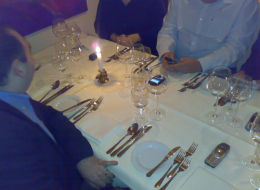People often say we're multi-tasking ourselves to death. Is that really what we're doing? I think not.
I call what we're doing today continuous partial attention, or cpa, for short.
Continuous partial attention and multi-tasking are two different attention strategies, motivated by different impulses. When we multi-task, we are motivated by a desire to be more productive and more efficient. Each activity has the same priority - we eat lunch AND file papers. We stir the soup AND talk on the phone. With multi-tasking, one or more activities is somewhat automatic, like eating lunch or stirring soup. That activity can be paired with another activity that's automatic or with an activity that requires more cognition, like writing an email or talking on the phone. At the core of multi-tasking is a desire to be more productive. We multi-task to CREATE more opportunity for ourselves -time to DO more and time to RELAX more.
In the case of continuous partial attention, we're motivated by a desire not to miss anything. There's a kind of vigilance that is not characteristic of multi-tasking. With cpa, we feel most alive when we're connected, plugged in and in the know. We constantly SCAN for opportunities - activities or people - in any given moment. With every opportunity we ask, "What can I gain here?"
Why care about the difference between multi-tasking and cpa? 
Continuous partial attention is an always on, anywhere, anytime, any place behavior that creates an artificial sense of crisis. We are always in high alert. We reach to keep a top priority in focus, while, at the same time, scanning the periphery to see if we are missing other opportunities, and if we are, our very fickle attention shifts focus. What's ringing? Who is it? How many emails? What's on my list? What time is it in Beijing?
In this state of always-on crisis, our adrenalized "fight or flight" mechanism kicks in. This is great when we're being chased by tigers. But how many of those 500 emails a day is a TIGER? How many are flies? Is everything an emergency? Our way of using the current set of technologies would have us believe it is.
Over the last twenty years, we have become expert at continuous partial attention and we have pushed ourselves to an extreme that I call, CONTINUOUS continuous partial attention. There are times when cpa is the best attention strategy for what we're doing; and, in small doses, continuous partial attention serves us well.
More and more, many of us feel the "shadow side" of cpa -- over-stimulation and lack of fulfillment. The latest, greatest powerful technologies are now contributing to our feeling increasingly powerless. Researchers are beginning to tell us that we may actually be doing tasks more slowly and poorly.
And that's not all. We have more attention-related and stress-related diseases than ever before. Continuous continuous partial attention and the fight or flight response associated with it, sets off a cascade of stess hormones, starting with norepinephrin and its companion, cortisol. As a hormone, cortisol is a universal donor. It can attach to any receptor site. As a result, dopamine and seratonin -the hormones that help us feel calm and happy - have nowhere to go because cortisol has taken up the available spaces. The abundance of cortisol in our systems has contributed to our turning to pharmaceuticals to calm us down and help us sleep.
Our opportunity: remembering to find the OFF switch on our devices, now and then, and tune in to the present with engaged attention.
I believe attention is the most powerful tool of the human spirit. We can enhance or augment our attention with practices like meditation and exercise, diffuse it with technologies like email and Blackberries or alter it with pharmaceuticals. In the end, though, we are fully responsible for how we choose to use this extraordinary tool.